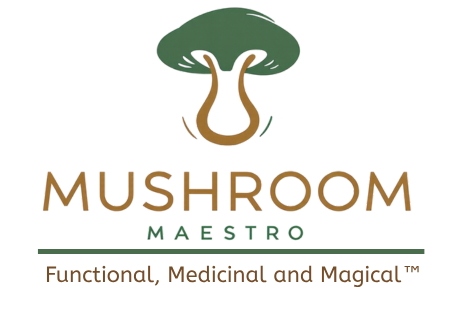Introduction: Unveiling the Dual Power of Psychedelics and Nootropic Mushrooms
In recent years, the conversation surrounding mental health, cognitive performance, and holistic wellness has taken a revolutionary turn. At the forefront of this transformation are nootropic mushrooms, renowned for their brain-boosting compounds, and psychedelics, long misunderstood but now undergoing a renaissance of scientific validation. As interest in alternative and integrative therapies grows, so too does our understanding of the psychedelics benefits offered by these remarkable fungi. Their role extends beyond mere cognitive enhancement; they promise a multifaceted impact on emotional resilience, creativity, neuroplasticity, and overall psychological well-being. With research mounting and societal stigma waning, the blending of nootropics and psychedelics presents an exciting, emerging domain within memory and cognitive enhancement.
You may also like: The Ultimate Guide to the Best Nootropic Mushrooms for Memory and Cognitive Enhancement
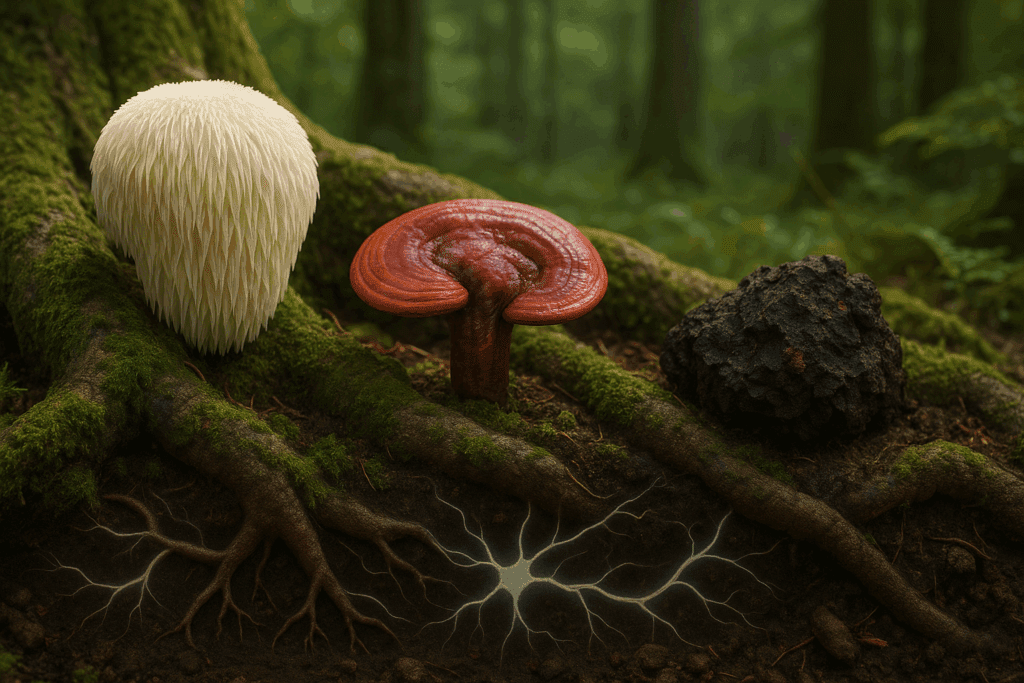
Understanding the Foundations of Nootropic Mushrooms
Nootropic mushrooms, often labeled as “smart fungi,” have carved a niche in the domain of cognitive enhancement for their ability to support memory, focus, and mental clarity. Among the most well-known varieties are Lion’s Mane (Hericium erinaceus), Cordyceps, Reishi, and Chaga. Lion’s Mane, in particular, has attracted widespread attention due to its active compounds, hericenones and erinacines, which stimulate nerve growth factor (NGF)—a protein critical to the growth and maintenance of neurons. This property has led to investigations into its potential to combat neurodegenerative conditions such as Alzheimer’s disease and dementia.
Cordyceps is often praised for enhancing energy metabolism, making it popular among athletes and those with demanding cognitive workloads. Meanwhile, Reishi and Chaga are known for their adaptogenic qualities, helping the body and brain manage stress more efficiently. What unites these mushrooms is not only their long-standing use in traditional medicine but also a growing body of scientific literature supporting their nootropic properties. Unlike synthetic stimulants, nootropic mushrooms offer a gentler, more sustainable approach to mental acuity, aligning well with the body’s natural rhythms.
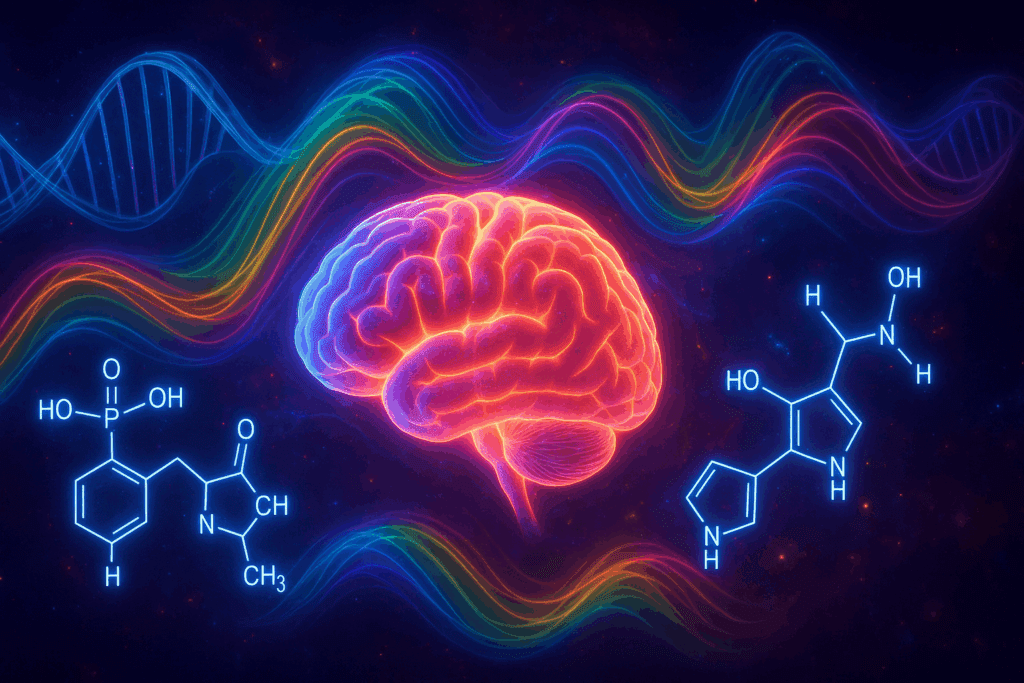
The Rise of Psychedelics in Neuroscience and Mental Health
Psychedelics, once relegated to the fringes of medical science due to socio-political stigma, are now experiencing a dramatic resurgence in neuroscience research. Compounds such as psilocybin (found in “magic mushrooms”), LSD, DMT, and mescaline are being reevaluated through the lens of clinical rigor. Researchers are uncovering that these substances may hold therapeutic potential for treatment-resistant depression, PTSD, anxiety disorders, and end-of-life psychological distress.
The psychedelic experience, marked by altered perception, emotional introspection, and ego dissolution, appears to facilitate profound shifts in mental patterns. Recent studies at Johns Hopkins University and Imperial College London have revealed that psilocybin can induce a temporary increase in neuroplasticity—the brain’s ability to reorganize and form new neural connections. This reorganization may explain the observed long-term benefits on mood and cognition following even a single guided psychedelic session. As we delve further into the benefits of psychedelic drugs, it becomes clear that their potential extends far beyond recreational use and into the realm of transformative mental healthcare.
Exploring the Psychedelics Benefits for Cognitive Function
One of the most compelling arguments in favor of psychedelics lies in their impact on cognitive flexibility and creativity. These are critical dimensions of intelligence that allow individuals to adapt to new situations, think abstractly, and solve problems innovatively. Psychedelics appear to temporarily dampen the activity of the brain’s default mode network (DMN), a system associated with self-referential thinking and rumination. By quieting the DMN, psychedelics create a mental environment conducive to novel insights and cognitive breakthroughs.
Several anecdotal reports and controlled studies suggest that users often emerge from psychedelic experiences with a renewed sense of purpose, clarity, and intellectual openness. While it’s important to note that these outcomes can vary depending on the set (mindset) and setting (environment), when administered responsibly—especially in clinical or therapeutic contexts—the psychedelics benefits can be profound. Additionally, early-stage studies have found enhancements in associative thinking and divergent thinking post-psychedelic use, supporting the theory that these substances can indeed foster enhanced cognition, especially when used adjunctively with cognitive therapies or creative practices.
Nootropic Mushrooms and Neurogenesis: The Science of Growing New Brain Cells
Another area where nootropic mushrooms shine is in their capacity to promote neurogenesis—the birth of new neurons. Unlike most conventional cognitive enhancers that merely amplify neurotransmitter levels temporarily, certain mushrooms stimulate actual structural changes in the brain. Lion’s Mane, for instance, has demonstrated neuroregenerative effects in both in vitro and animal studies, where it enhanced the recovery of damaged nerve cells and promoted myelination—the process of coating neurons to enhance signal transmission.
This property makes nootropic mushrooms a promising intervention not just for age-related cognitive decline but also for recovery from traumatic brain injuries, strokes, and other forms of neural damage. Moreover, this regenerative potential becomes especially powerful when considered in tandem with psychedelics, which may enhance the brain’s receptivity to such growth signals. Together, nootropics and psychedelics may form a complementary duo in advancing cognitive rehabilitation and long-term brain health strategies.
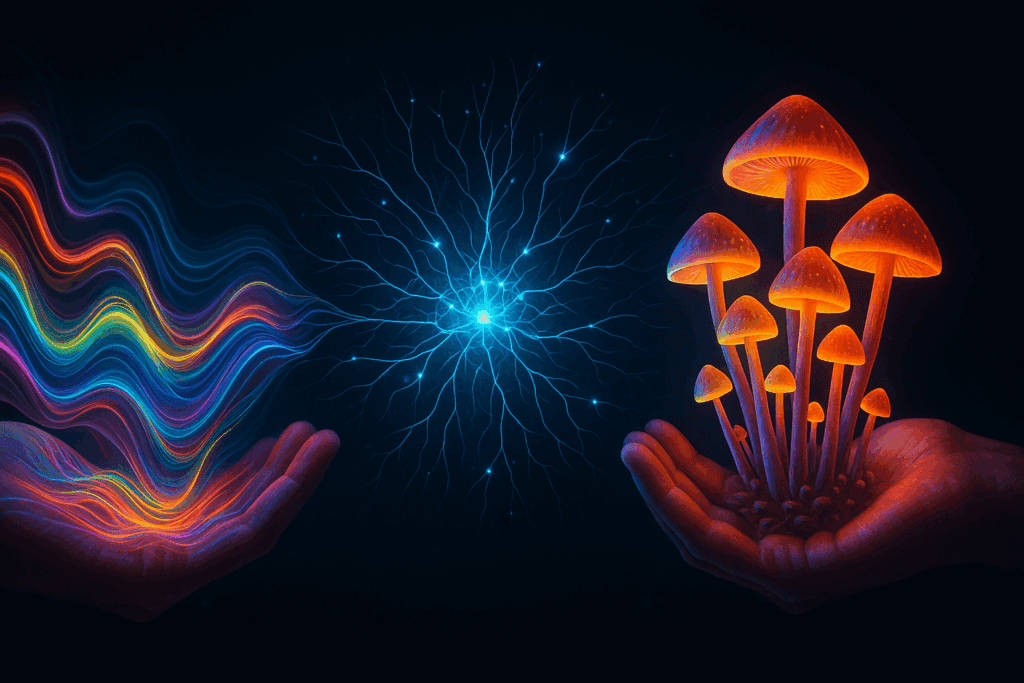
The Synergy Between Nootropic Mushrooms and Psychedelics
What happens when two powerful agents—nootropic mushrooms and psychedelics—are brought together within a single protocol? Emerging integrative frameworks suggest a potentially synergistic relationship. While psychedelics may open the door to psychological insights and altered neural patterns, nootropic mushrooms can help consolidate these changes by supporting neuroplasticity and neuroregeneration. For example, taking Lion’s Mane during the integration phase following a psilocybin session may prolong and deepen the therapeutic effects.
Furthermore, many holistic practitioners now advocate for microdosing regimens that combine low doses of psilocybin with daily nootropic support. The goal is to maintain a subtle but sustained enhancement of mood, focus, and cognitive flexibility over time. Although large-scale, long-term studies are still lacking, anecdotal reports and smaller clinical observations support the idea that this combination may optimize the psychedelics benefits while minimizing potential side effects such as fatigue or emotional overstimulation. The synergy lies not just in their pharmacological effects but also in their alignment with a lifestyle centered on self-awareness, mindfulness, and intentional healing.
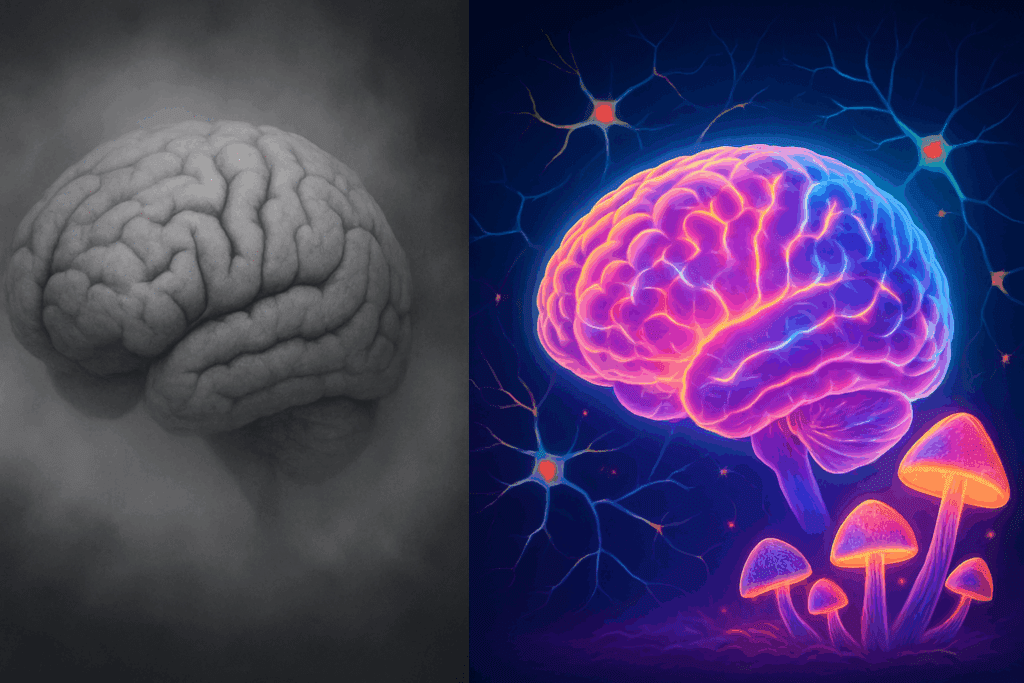
Psychedelics Benefits in Treating Memory Disorders and Cognitive Decline
Neurodegenerative diseases like Alzheimer’s and Parkinson’s pose some of the most daunting challenges in modern medicine. Traditional pharmaceuticals offer only modest symptomatic relief and often come with significant side effects. In this context, the psychedelics benefits for neurodegeneration are gaining traction. Preliminary research has indicated that psilocybin and LSD may stimulate neurogenesis, reduce inflammation, and even mitigate amyloid plaque accumulation—hallmarks of Alzheimer’s disease.
In parallel, nootropic mushrooms are being examined for similar effects. Lion’s Mane’s influence on NGF production suggests it could slow or even reverse early-stage cognitive decline. Combining such mushrooms with psychedelic-assisted therapy could offer a two-pronged approach: immediate relief from depression and anxiety, which often co-occur with memory loss, alongside long-term cognitive support. This integrated model not only addresses symptoms but also targets underlying pathophysiological processes—an approach that epitomizes the next generation of neurocognitive therapeutics.
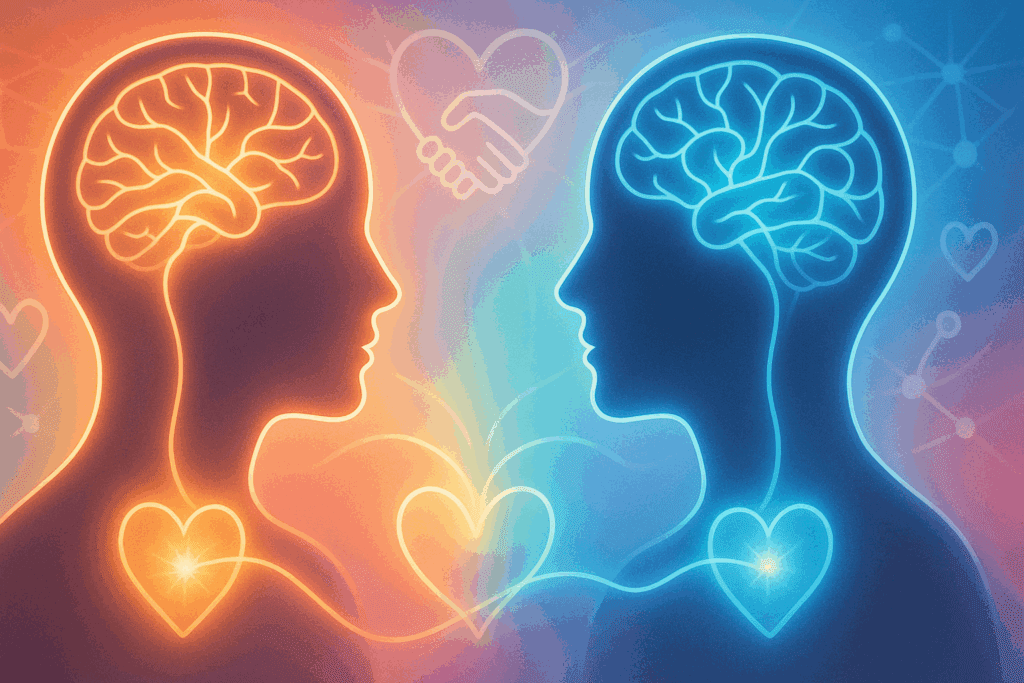
Are Psychedelics Good for Emotional Intelligence and Interpersonal Functioning?
While much of the discourse around nootropics and psychedelics focuses on individual cognition, emotional intelligence (EQ) is an equally vital component of mental health. Research increasingly supports the idea that psychedelics can enhance traits such as empathy, openness, and emotional attunement. These outcomes are especially valuable in therapeutic settings where relational dynamics are key, such as couples therapy or group interventions.
By facilitating greater emotional insight and reducing defensive thought patterns, psychedelics often enable users to better understand their own emotions and those of others. This can lead to improved communication, reduced interpersonal conflict, and stronger social bonds. Integrating nootropic mushrooms during these emotionally rich phases may provide the neurological scaffolding to reinforce these behavioral shifts. Thus, when asking, “Are psychedelics good for personal growth?” the evidence increasingly points to a qualified yes—particularly when used within guided, intentional frameworks.
Psychedelics Benefits in Managing Anxiety, PTSD, and Depression
One of the most thoroughly investigated areas in psychedelic science is their application for mood disorders. High-profile clinical trials have demonstrated that psychedelics, particularly psilocybin and MDMA, can produce rapid and sustained reductions in symptoms of depression, anxiety, and PTSD. What distinguishes these treatments from conventional pharmacotherapy is their mechanism of action: rather than masking symptoms, psychedelics often enable users to confront and reprocess traumatic experiences.
Moreover, these substances appear to reboot the brain’s default emotional responses by increasing serotonin receptor sensitivity and decreasing amygdala overactivity—a neural correlate of fear and anxiety. In the weeks following a psychedelic session, individuals often report not just relief from symptoms but a newfound sense of resilience and optimism. Integrating nootropic mushrooms like Reishi and Chaga, with their calming and adaptogenic effects, may smooth the post-journey transition and further stabilize mood. This combinatory approach maximizes the benefits of psychedelic drugs while also acknowledging the importance of grounding and ongoing self-care.

Microdosing: A Modern Approach to Sustained Psychedelics Benefits
Microdosing—the practice of consuming sub-perceptual amounts of psychedelics—has exploded in popularity, especially among professionals seeking enhanced productivity, emotional balance, and creativity without the intensity of a full trip. Users typically follow structured protocols involving doses of psilocybin or LSD every few days, often paired with nootropic support from mushrooms like Lion’s Mane or Cordyceps.
Proponents report a wide array of benefits, including improved mood, clearer thinking, heightened intuition, and enhanced social ease. Although the scientific literature on microdosing is still in its infancy, early observational studies and self-reports are promising. Importantly, these regimens often emphasize intention, mindfulness, and personal development—elements that distinguish therapeutic use from recreational experimentation. As more data becomes available, microdosing may emerge as one of the most sustainable and accessible ways to harness the psychedelics benefits for cognitive and emotional well-being.
Ethical, Legal, and Safety Considerations in Psychedelic and Nootropic Use
As the popularity of psychedelics and nootropic mushrooms grows, so too does the need for clear ethical guidelines, legal reforms, and safety protocols. Despite their promising effects, psychedelics are still classified as Schedule I substances in many countries, including the United States, making access difficult and legal risk considerable. However, growing decriminalization movements and FDA breakthroughs suggest that change is on the horizon.
Safety must also be prioritized. Psychedelics are not suitable for everyone, particularly individuals with a personal or family history of psychosis or bipolar disorder. Proper screening, dosage control, and set-and-setting considerations are essential to minimize adverse reactions. Similarly, nootropic mushrooms, while generally safe, can cause allergic reactions or interact with medications. The path forward involves rigorous clinical trials, professional supervision, and informed consent.
Ethically, practitioners and researchers must avoid commodifying these sacred substances without respecting their indigenous roots and ceremonial uses. Responsible integration means acknowledging the cultural, historical, and spiritual contexts in which these agents have long been revered.
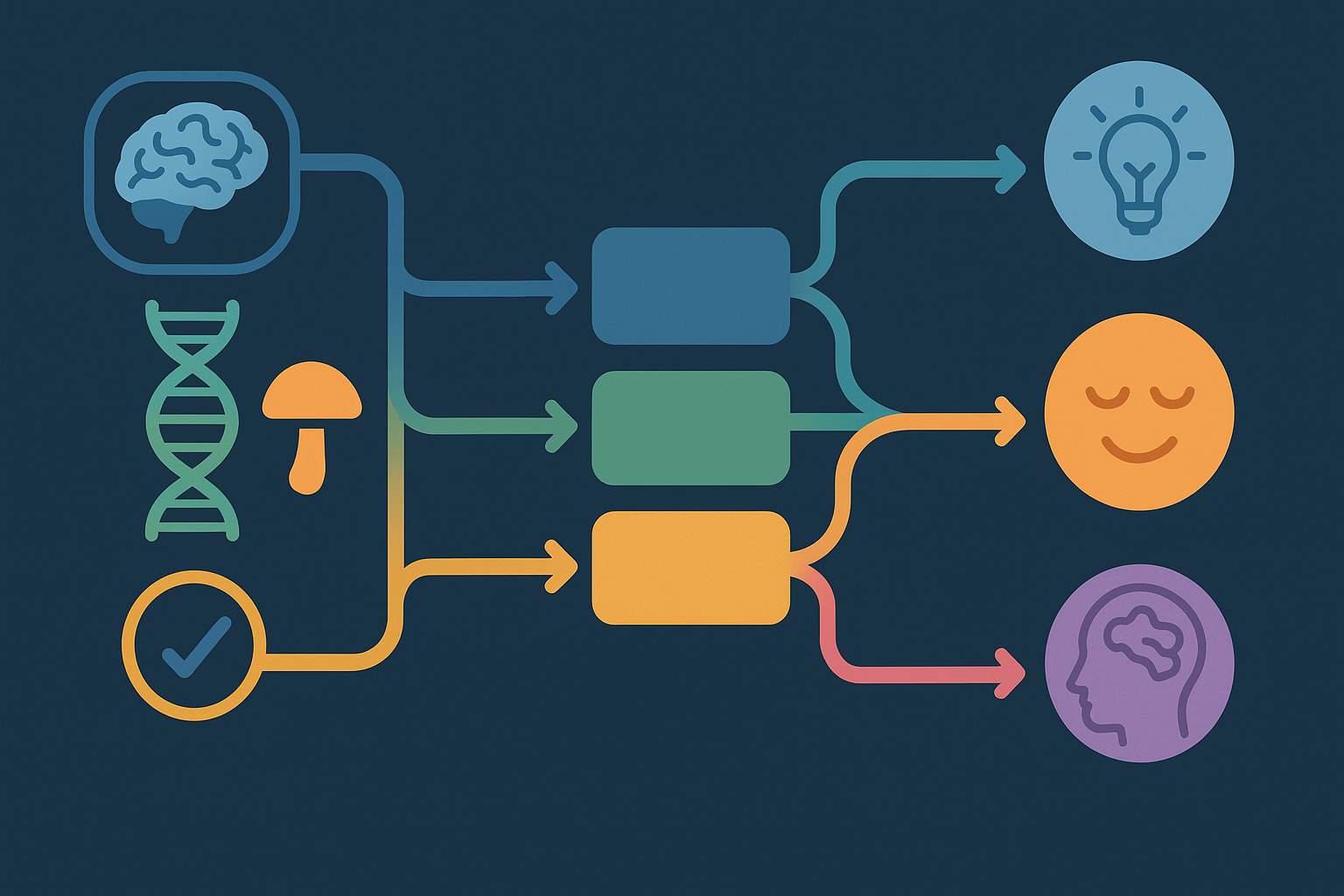
The Future of Personalized Psychedelic Therapies and Nootropic Stacking
Looking ahead, the future of cognitive and emotional enhancement may lie in personalized protocols that integrate nootropics and psychedelics according to individual genetic, neurological, and psychological profiles. Advances in precision medicine, such as neuroimaging, pharmacogenomics, and digital health tracking, are enabling clinicians to tailor interventions based on how a person’s brain responds to different compounds.
For instance, someone with a high baseline of anxiety might benefit from a combination of Reishi mushroom and low-dose psilocybin to promote relaxation and cognitive reframing. In contrast, another individual seeking to overcome creative blockages might benefit from Lion’s Mane paired with a carefully timed microdose of LSD. These targeted approaches aim to reduce the trial-and-error nature of current self-guided protocols and elevate the safety and efficacy of psychedelic therapy.
Holistic Lifestyle Integration: Enhancing Psychedelics Benefits Beyond the Session
The long-term effectiveness of any psychedelic or nootropic intervention depends heavily on how well it is integrated into a person’s daily life. A one-off experience, however profound, may fade unless supported by sustained behavioral and cognitive practices. This is where habits such as meditation, journaling, therapy, nutrition, and physical activity play a pivotal role.
Using nootropic mushrooms as part of a daily wellness routine can help reinforce the neural gains initiated during psychedelic sessions. For example, Cordyceps may enhance energy and motivation to support consistent physical exercise, while Lion’s Mane can maintain cognitive sharpness needed for reflective journaling or therapeutic engagement. When the gains of a psychedelic session are nurtured through mindful living, their psychedelics benefits can become enduring pillars of personal development.
Cultural Reverence and the Reclamation of Indigenous Knowledge
While science plays a central role in validating the therapeutic potential of psychedelics and nootropics, it is crucial to honor the ancestral traditions from which these substances originate. For centuries, Indigenous communities across the globe have used psychoactive mushrooms and plants in ceremonial contexts to foster healing, community bonding, and spiritual insight.
Modern psychedelic research and commercialization must not ignore this deep well of wisdom. Collaborating with Indigenous leaders, supporting land sovereignty, and practicing cultural humility are ethical imperatives as we explore these tools. Respecting the ceremonial use of psychedelics doesn’t just enhance moral accountability—it also enriches our understanding of their full spectrum of application. In doing so, we ensure that our pursuit of healing through these substances remains inclusive, holistic, and ethically sound.
Frequently Asked Questions About Psychedelics Benefits and Nootropic Mushrooms
1. How do psychedelics interact with nootropic mushrooms in long-term mental health support?
While the article discusses short-term synergy, one of the more exciting frontiers lies in long-term co-administration strategies. Nootropic mushrooms like Lion’s Mane help promote neurogenesis and nerve regeneration, while psychedelics initiate short-term neuroplasticity and emotional insights. When taken cyclically or during post-psychedelic integration phases, nootropics may prolong cognitive benefits by nurturing the new neural pathways established during the psychedelic experience. Additionally, combining these substances within wellness frameworks such as meditation or therapy amplifies results. Over time, this strategic pairing could become foundational in managing chronic mental health conditions like anxiety, ADHD, or treatment-resistant depression.
2. What are some lesser-known psychedelics benefits in workplace productivity?
Although most research centers around mental health, emerging corporate wellness models now explore how psychedelics may influence professional performance. Low-dose psychedelics have been linked to increased adaptability, enhanced creativity, and reduced workplace burnout. Executives and entrepreneurs engaging in supervised microdosing protocols often report breakthroughs in problem-solving and team dynamics. By fostering empathy and reducing ego-centric thinking, psychedelics help dismantle communication barriers—often a significant hurdle in collaborative environments. The subtle, sustained psychological shifts may create emotionally intelligent leadership cultures across industries.
3. Are psychedelics good for enhancing self-awareness and long-term behavioral change?
One of the lesser-emphasized yet profound outcomes is the role of psychedelics in fostering metacognition. They can catalyze introspection, helping individuals become more aware of their habits, thought loops, and emotional triggers. This self-awareness often lays the groundwork for meaningful and lasting behavioral change. In contrast to surface-level interventions, psychedelic journeys often act as a mirror to subconscious patterns. When combined with integration coaching and lifestyle adjustments, this reflective experience frequently leads to improved emotional regulation, better decision-making, and healthier relationships.
4. How do cultural and spiritual traditions enhance psychedelics benefits?
Modern medicine increasingly acknowledges what indigenous cultures have known for centuries—that setting, intention, and ritual profoundly influence the healing potential of psychedelics. Sacred plant ceremonies involving mushrooms or ayahuasca, for instance, provide structured environments where participants are supported emotionally, spiritually, and communally. These traditions often include post-ceremony reflection, nature immersion, and ancestral teachings. Such practices not only enhance the psychological impact but also ground the experience within a meaningful context. Integrating cultural reverence can deepen the psychedelics benefits beyond neurobiology, transforming them into holistic tools for spiritual and communal growth.
5. What are the benefits of psychedelic drugs in treating existential anxiety and burnout?
While conventional treatments address surface symptoms, psychedelics appear uniquely suited for existential distress. This includes burnout, mid-life crises, and spiritual emptiness—conditions increasingly common in modern societies. Psychedelics may help reorient individuals to a deeper sense of purpose by disrupting maladaptive thought patterns and reigniting awe and connection. Studies on psilocybin-assisted therapy for terminal patients reveal significant reductions in fear of death and enhanced appreciation for life. Similarly, those struggling with meaninglessness often report profound emotional shifts and renewed motivation after psychedelic sessions.
6. Can psychedelics and nootropic mushrooms support neurodivergent individuals?
There’s growing interest in how these substances may assist individuals with ADHD, ASD, and other neurodivergent conditions. While data remains limited, early anecdotal reports suggest improved focus, emotional regulation, and reduced sensory overwhelm following psychedelic-assisted therapy. Nootropic mushrooms like Lion’s Mane may further aid executive functioning and task persistence, especially when used consistently. Importantly, microdosing protocols tailored for neurodivergent profiles emphasize lower starting doses and extended observation periods. More inclusive research is needed, but preliminary findings suggest a compelling future application for both psychedelics and nootropics in this space.
7. How are psychedelics good for fostering resilience in high-stress professions?
In high-demand fields like medicine, law enforcement, and the military, chronic stress and trauma are rampant. Psychedelic therapies offer a means of emotional processing and recovery that traditional interventions often fail to address. For example, MDMA-assisted therapy has shown success in helping veterans with PTSD confront traumatic memories in a safe and controlled setting. When integrated with daily nootropics to restore cognitive function, this approach can facilitate sustainable recovery. As awareness of mental health needs grows, psychedelic and nootropic pairings may become essential tools in building psychological resilience among frontline professionals.
8. Exploring Psychedelics Benefits in Creative Professions and Artistic Flow
Beyond conventional productivity, psychedelics have long been associated with creativity and artistic insight. Many artists and musicians credit psychedelic experiences with unlocking their most innovative work. These substances can help bypass cognitive rigidity and stimulate divergent thinking—core to the creative process. Nootropic mushrooms complement this by supporting sustained focus and mental clarity, enabling artists to execute their visions more effectively. For writers, designers, and other creatives, the dual use of psychedelics and nootropics may enhance both the visionary and practical sides of their work.
9. What role do psychedelics benefits play in age-related cognitive preservation?
As life expectancy rises, maintaining cognitive health into older age becomes increasingly important. Preliminary research indicates that psychedelics may aid in slowing cognitive decline through neurogenesis, mood enhancement, and inflammation reduction. Unlike traditional drugs that treat symptoms, psychedelics may work on the underlying neural architecture. When paired with Lion’s Mane or Chaga mushrooms, which promote nerve growth and brain repair, the combination could represent a novel approach to cognitive aging. Seniors exploring these therapies under medical supervision often report improved clarity, memory, and emotional vitality.
10. Psychedelics Benefits in Redefining Success, Identity, and Mental Wellness
One of the most transformative aspects of psychedelic use is their capacity to deconstruct rigid self-concepts. Individuals frequently emerge from sessions with redefined values, shifting their focus from external achievements to internal alignment. This re-evaluation often brings reduced anxiety, improved relationships, and enhanced well-being. Psychedelics promote what researchers call “psychological flexibility,” which is key to adapting to life’s inevitable challenges. Integrating these insights with nootropic support can empower people to rebuild their lives in more authentic and fulfilling ways.
Conclusion: Unlocking the Transformative Potential of Psychedelics Benefits and Nootropic Mushrooms
The convergence of nootropic mushrooms and psychedelics represents a groundbreaking shift in how we understand, nurture, and expand the human mind. What once existed on the margins of science and society now stands at the vanguard of cognitive and emotional healing. Through rigorous research, clinical trials, and community-led exploration, we are beginning to grasp the immense psychedelics benefits available for those seeking to enhance memory, creativity, emotional intelligence, and psychological resilience.
Crucially, the growing body of evidence suggests that these substances do not merely offer temporary fixes but may enable long-lasting, structural changes in brain function. Whether used in full-dose therapeutic sessions or subtle microdosing regimens, when combined with the cognitive nourishment of nootropic mushrooms, psychedelics become more than medicine—they become tools for conscious evolution.
As science catches up with ancient wisdom, the question is no longer simply “Are psychedelics good?” but rather, how can we use them responsibly, ethically, and effectively to unlock human potential in ways previously unimaginable. The journey is just beginning, but the path ahead is lit with promise, insight, and the transformative power of nature’s most enigmatic fungi.
Further Reading :
Psychedelic and Dissociative Drugs
The emergence of psychedelics as medicine
This Is Your Brain on Mushrooms: How Does Psychedelic-Assisted Therapy Work?
